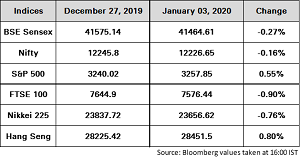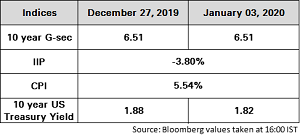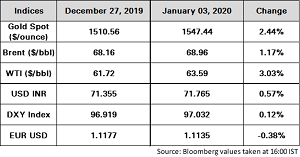Indian Economic Update
- Balance of Payments (BoP) printed a moderate surplus in Q2 FY2020 as improvement in Current Account offset a stressed capital account. BoP clocked USD 5.1 billion surplus in Q2. Overall surplus for H1 FY2020 stands at USD 19.1 billion, as compared to USD 13.2 billion deficit in Apr-Sep 2018.
- Current Account Deficit (CAD) narrowed sharply on a sequential basis to USD 6.3 billion (0.9% of GDP) from USD 14.2 billion (2.0% of GDP) in Q1 FY2020. The sequential improvement came on the back of a lower merchandise trade deficit.
- Capital account notably stressed in Q2 FY2020, as all components weakened.
- Overall capital account surplus (including errors and omission) fell to USD 11.4 billion in Q2 FY2020 as Foreign Direct Investment (FDI) and Foreign Portfolio Investment (FPI) inflows moderated, external borrowings declined and banking capital saw net outflows.
- Manufacturing Purchasing Managers Index (PMI) rose in December to a joint fastest rate along with March at 52.7, evidence that the Indian economy may have bottomed out. The reading was 51.2 in November.
- The Finance Minister announced INR 102 trillion infrastructure spending plan through Mar 2025 involving different ministries and projects.
- The central government's fiscal deficit rose to INR 8.078 trillion in April-November, accounting for 114.8% of the Budget estimate for the full financial year.
- India Core industries growth came in at -1.6% in November versus -5.8% in October.
Global Update
- The US President has confirmed that the ‘Phase-One’ trade deal will be signed on Jan 15, 2020 and Phase Two negotiations will begin shortly after that.
- The People’s Bank of China (PBOC) announced that it would cut its Reserve Requirement Ratio (RRR) by 0.5%, injecting CNY 800 billion into the financial system. The RRR for larger banks has been lowered from 13% to 12.5% and the RRR of smaller banks has been reduced from 11% to 10.5%. The move will be effective Jan 12, 2020.
- China trade negotiator Mr Liu He will lead a trade delegation to Washington on Saturday, according to South China Morning Post (SCMP) report. The visit will be to sign the Phase One trade deal.
- Global crude prices have risen sharply in response to the latest Middle Eastern geopolitical developments. Mr Qassem Soleimani, the Iranian general who led the Revolutionary Guards’ Quds force, was killed in a U.S. airstrike in Baghdad.

Indian equity markets remained flat tracking weak global cues and profit booking as holiday week saw muted trade. Weakness in banking, auto and IT shares dragged markets lower.
During the week Sensex lost 0.27% to close at 41464.61 while Nifty declined 0.16% to close at 12226.65.

Indian Government bonds remained steady as market participants refrained from large bets on caution ahead of INR 160 billion gilt auction on Friday.
The 10Y benchmark yield ended at 6.51% as compared to the previous week’s close of 6.51%.
Global crude prices rose in response to the latest Middle Eastern geopolitical developments with Brent crude oil prices trading at approximately USD 68.16/barrel (bbl) mark, showing approximately 3% overnight rally.
Gold jumped to three-month high level as weakness in the dollar countered optimism about the United States and China signing an interim trade deal soon.

The Indian Rupee remained weak amid dollar demand by importers. Volumes were muted due to lack of significant cues.
Dollar index traded higher levels ahead of Fed December policy minutes.
EUR/USD and GBP/USD is trading lower. With the Brexit process set to cause another year of Pound uncertainty, the pair’s gains have been limited.
USD/JPY is trading marginally higher.
Source: ICICI Bank Research, Private Banking Investment Strategy Team, Bloomberg and CRISIL.



